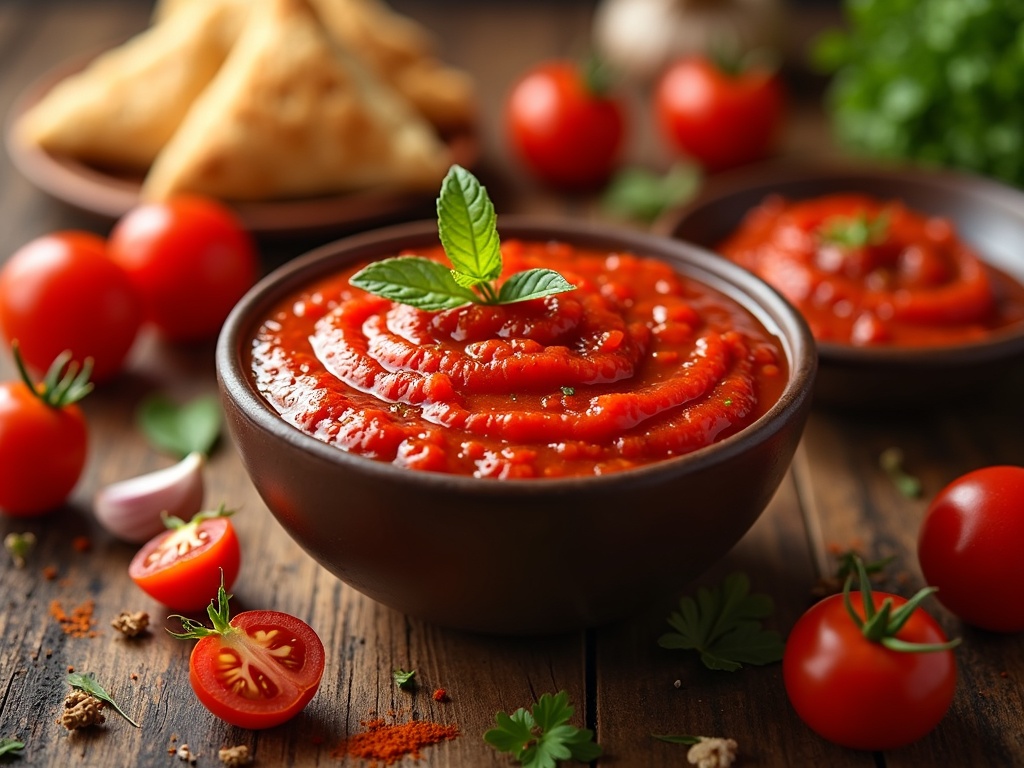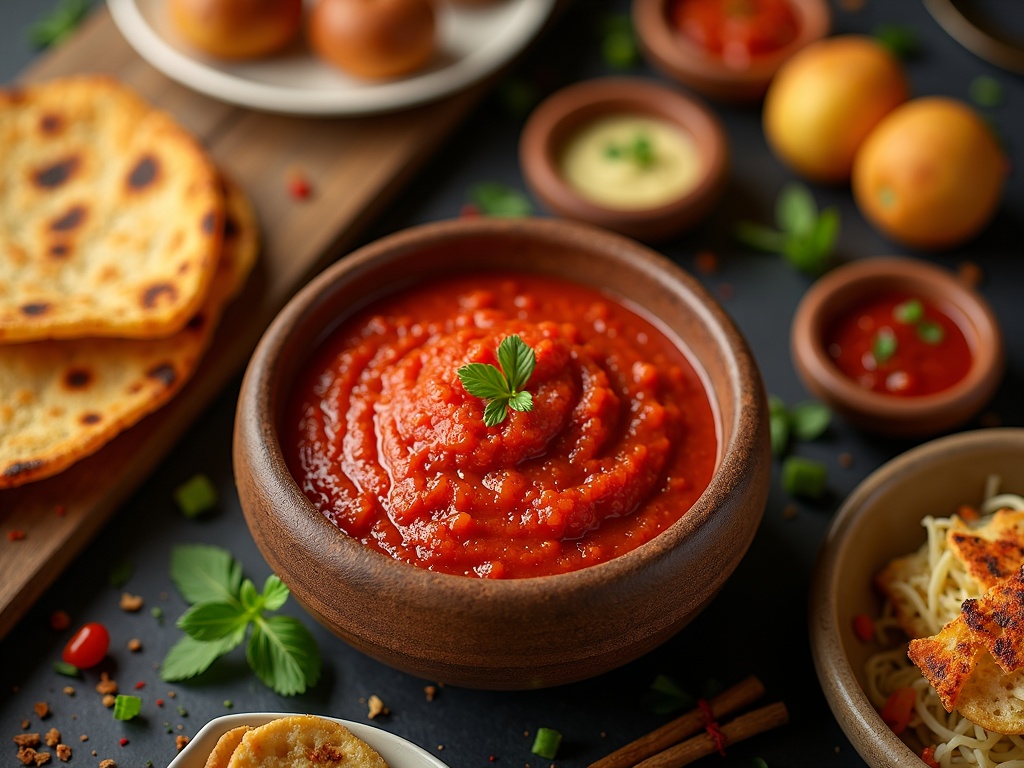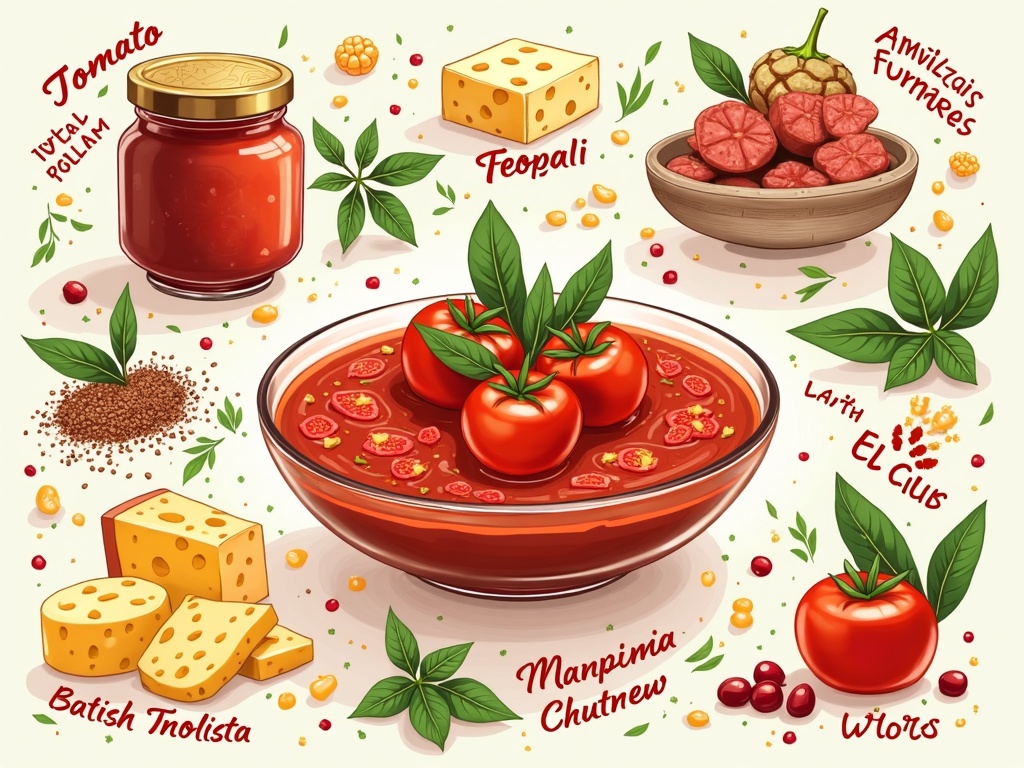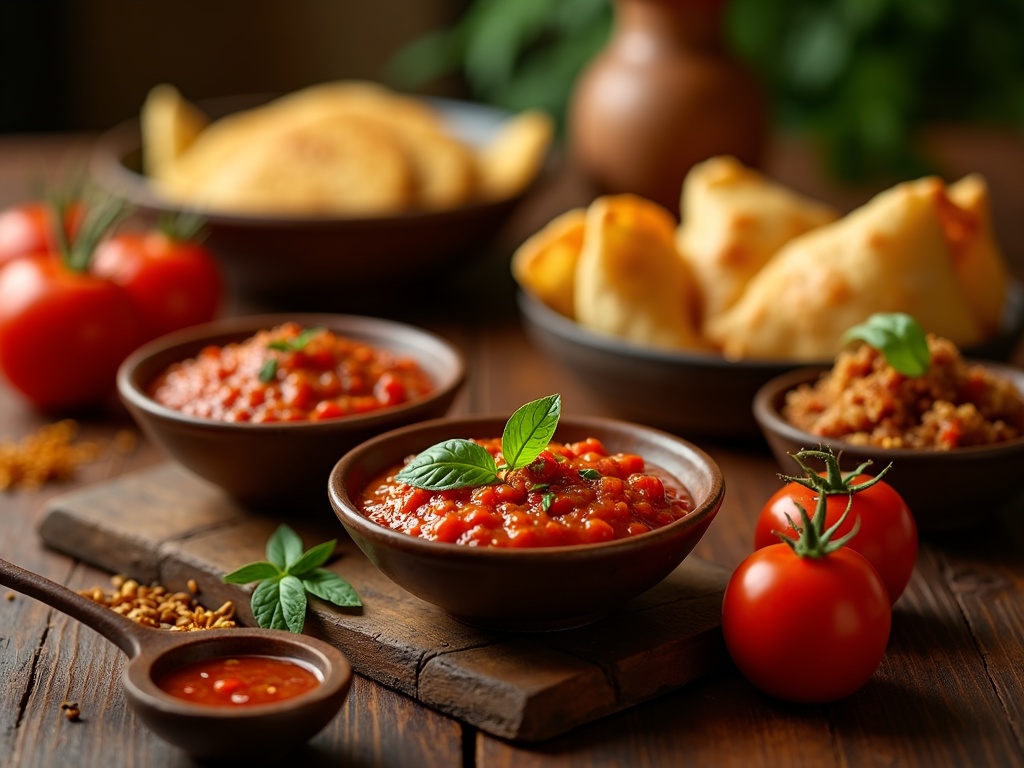Tomato chutney, a flavorful Indian condiment mixing sweet, tangy, and spicy notes, has gained popularity with a 7.36% CAGR between 2021 and 2026. This versatile accompaniment has evolved from its traditional origins to become a global culinary favorite, appearing in gourmet food stores and restaurant menus across the world while retaining its nutritional benefits.
Find In This Article
Key Takeaways
- Tomato chutney contains just 25 calories per 2 tablespoon serving with 6g of carbohydrates, 1g of protein, 0g fat, and provides 10% of daily recommended Vitamin C.
- The condiment features distinct regional variations across India, including South Indian versions with curry leaves and coconut, spicier North Indian varieties, sweet-sour Bengali adaptations, and Western Indian versions with added texture from nuts.
- Homemade tomato chutney requires simple ingredients including ripe tomatoes, aromatics, and spices, takes about 30 minutes to prepare, and keeps for up to two weeks in the refrigerator.
- Beyond traditional pairings with dosa and idli, tomato chutney works excellently as a sandwich spread, marinade, pasta sauce enhancer, and dipping sauce.
- The condiment has adapted globally, with British versions being vinegar-preserved, Caribbean variations incorporating tropical fruits, and Middle Eastern adaptations featuring pomegranate molasses.
The Rising Popularity of This Traditional Indian Condiment
The tomato chutney market is experiencing a remarkable surge, growing at an impressive 7.36% CAGR between 2021 and 2026. This flavorful condiment has journeyed far beyond its Indian roots to become a global culinary sensation. I’ve noticed how this tangy, spicy accompaniment has made its way onto tables worldwide, transforming everyday meals into extraordinary dining experiences.
Tomato chutney finds its origins in Indian cuisine, where it has been a staple for centuries. The rich culinary heritage of India gave birth to this versatile condiment that balances sweet, tangy, and spicy flavors perfectly. What started as a regional specialty has now captivated the taste buds of food enthusiasts across continents. Its ability to complement various dishes has helped it gain traction in international markets, appearing in gourmet food stores and restaurant menus alike.
Traditional Preparation Methods and Regional Variations
The traditional preparation of tomato chutney involves a harmonious blend of fresh tomatoes, onions, aromatic spices, and vinegar. This combination creates a depth of flavor that can range from mild to fiery hot, depending on personal preference. I find that the best tomato chutney balances these elements perfectly – the acidity of tomatoes, the pungency of onions, the complexity of spices, and the preservative quality of vinegar.
The beauty of tomato chutney lies in its regional diversity across India. Here are some notable variations:
- South Indian tomato chutney typically features a thicker consistency with curry leaves, mustard seeds, and often coconut for a tropical twist. This variation pairs wonderfully with breakfast items like idli and dosa. For a delightful alternative, coconut chutney offers a similar but distinctive South Indian flavor profile.
- North Indian versions tend to be spicier, incorporating green chilies, ginger, and sometimes dried fruits for a sweet-spicy balance. These varieties often complement paratha and roti.
- Bengali tomato chutney includes panch phoron (five-spice blend) and jaggery, creating a sweet-sour profile that’s simply irresistible.
- Western Indian variations often incorporate peanuts or sesame seeds for added texture and nutrition.
Each region has adapted the basic recipe to reflect local tastes and available ingredients. This adaptability has contributed significantly to its widespread acceptance both within India and internationally. The versatility of chutney recipes makes them perfect for experimentation in kitchens around the world.
What makes tomato chutney particularly appealing is its practical nature. Unlike many condiments that serve a single purpose, tomato chutney functions as a dip, spread, marinade, or cooking ingredient. This multi-functional quality has helped it transition from ethnic food stores to mainstream supermarkets.
The recent surge in popularity can also be attributed to growing interest in global cuisines and authentic flavors. Food enthusiasts are increasingly seeking bold, complex flavor profiles, and tomato chutney delivers exactly that. Its combination of acidity, sweetness, and heat creates a taste experience that’s both fascinating and satisfying.
Additionally, tomato chutney aligns perfectly with current health trends. Made primarily from vegetables and spices, it offers a flavorful alternative to processed condiments. Many home cooks and commercial producers now create versions with reduced sugar and salt, catering to health-conscious consumers without sacrificing taste.
The rise of fusion cuisine has further elevated tomato chutney’s status, with innovative chefs incorporating it into non-traditional applications like gourmet burgers, artisanal sandwiches, and even pasta dishes. This creative adaptation has introduced the condiment to audiences who might otherwise never have encountered it.
A Healthy Alternative to Common Condiments
Tomato chutney offers a delicious way to add flavor to meals while maintaining nutritional awareness. With just 25 calories per 2 tablespoon serving, this vibrant condiment packs a flavorful punch without weighing down your daily calorie count. I’ve found it to be an excellent substitute for higher-calorie options like ketchup or barbecue sauce when I’m looking to keep meals lighter.
The nutritional profile is impressive beyond just the calorie count. Each serving contains 6g of carbohydrates, 1g of protein, and 0g of fat, making it a balanced addition to many dishes. What really stands out is that a single serving provides 10% of your daily recommended Vitamin C intake, giving your immune system a helpful boost with every dollop.
Nutritional Benefits Worth Noting
The health advantages of tomato chutney extend well beyond basic nutrition. It’s particularly rich in lycopene, a powerful antioxidant that gives tomatoes their vibrant red color. This compound has been linked to various health benefits, including potential protection against certain chronic conditions and supporting heart health.
The antioxidant properties found in tomato chutney help combat free radicals in the body, potentially reducing oxidative stress. These qualities make it not just a tasty addition to your plate, but a functional one as well.
When comparing common condiments, the differences become clear:
- Tomato chutney (2 tbsp): 25 calories, 0g fat
- Ketchup (2 tbsp): Typically 40 calories, often with added sugars
- Barbecue sauce (2 tbsp): Usually 50-70 calories with higher sugar content
- Mayo-based sauces (2 tbsp): Often 100-200 calories with significant fat content
I’ve found tomato chutney to be particularly versatile as a spread on sandwiches, a dip for samosas, or even as an accompaniment to grilled meats. Its robust flavor means a little goes a long way, helping keep portions sensible.
For those looking to explore other healthy chutney varieties, there are numerous options available. Another excellent choice is coconut chutney, which brings its own unique nutritional benefits to the table.

Create Your Perfect Batch at Home
Making tomato chutney at home is simpler than you might think, and the results are far superior to store-bought versions. With just a handful of ingredients and about 30 minutes, I can create a vibrant, flavorful condiment that elevates everything from sandwiches to rice dishes.
Essential Ingredients and Preparation
I always start with 3 cups of ripe tomatoes as the foundation of a great chutney. The quality of your tomatoes makes all the difference in the final product. Look for tomatoes that yield slightly to gentle pressure and have a deep, sweet aroma. Avoid those with blemishes or green spots, as they’ll contribute unwanted bitterness.
The aromatics provide the backbone of flavor: 1 medium onion, 3-4 garlic cloves, and a 1-inch piece of fresh ginger create a perfect balance. For heat, 2-3 green chilies work perfectly, but you can adjust according to your spice preference.
The tempering spices bring everything together: 1 teaspoon of mustard seeds adds a pleasant pop, while ½ teaspoon of turmeric provides both color and earthy notes. The 2 tablespoons of vinegar aren’t just for flavor—they help preserve your chutney for longer storage.
To begin the cooking process, I heat a tablespoon of oil in a pan and add the mustard seeds until they start to pop. Then I add finely chopped onions, garlic, ginger, and green chilies, sautéing until the onions turn translucent. This aromatic base is what gives homemade chutney its depth of flavor.
Next, I add chopped tomatoes, turmeric, salt, and a pinch of sugar to balance the acidity. The mixture simmers for about 15-20 minutes until the tomatoes break down completely and the mixture thickens. After cooling slightly, I blend until smooth and finish with vinegar.
For those with dietary restrictions, this recipe is naturally gluten-free. For a vegan version, simply ensure you’re using plant-based sugar, as some sugars are processed with bone char. The recipe is incredibly adaptable—you can use apple cider vinegar instead of regular vinegar for a slightly different flavor profile.
The finished chutney should have a bright, tangy flavor with subtle heat and sweetness. If you prefer a chunkier texture, pulse rather than blend completely. For a smoother consistency similar to coconut chutney, blend thoroughly and strain if desired.
I find tomato chutney keeps well in the refrigerator for up to two weeks in an airtight container. For longer storage, consider processing in sterilized jars using proper canning techniques.
The versatility of this chutney is remarkable—spread it on toast, use it as a dipping sauce for snacks, or serve alongside curry and rice. You can also customize the basic recipe by:
- Adding a handful of fresh cilantro at the end
- Incorporating a teaspoon of cumin seeds with the mustard seeds
- Stirring in a tablespoon of jaggery or brown sugar for extra sweetness
What makes homemade tomato chutney special is the ability to adjust every element to your taste. Too spicy? Reduce the chilies. Too tangy? Add more sugar. The beauty of making chutney at home is that you control exactly what goes into it, creating your perfect batch every time.
Versatile Ways to Enjoy Your Chutney
Tomato chutney stands out as one of the most adaptable condiments in Indian cuisine. I’ve discovered countless ways to incorporate this tangy, spicy mixture into meals beyond its traditional applications. The vibrant color and robust flavor profile make it perfect for enhancing dishes across various culinary traditions.
Traditional Pairings
In South Indian cuisine, tomato chutney serves as an essential accompaniment to several beloved dishes. The combination creates a perfect balance of flavors and textures:
- Dosa: The crispy, fermented rice crepes pair beautifully with the tangy-spicy notes of tomato chutney, creating a harmonious contrast.
- Idli: These steamed rice cakes have a subtle flavor that gets elevated when dipped in fresh tomato chutney.
- Bhaji: The deep-fried vegetable fritters become even more irresistible with a side of this vibrant condiment.
- Uttapam: These thick pancakes topped with vegetables find their perfect match in tomato chutney.
- Vada: The savory doughnut-shaped snacks gain an extra dimension when served alongside this versatile condiment.
I find that the acidity in tomato chutney cuts through the starchiness of these foods, creating a balanced bite. For a complete South Indian experience, you might want to try serving it alongside coconut chutney for complementary flavors.
Modern Applications
The versatility of tomato chutney extends far beyond traditional Indian cuisine. I’ve incorporated it into numerous contemporary dishes with excellent results:
As a sandwich spread, tomato chutney brings an unexpected punch to ordinary sandwiches and wraps. It works particularly well with grilled vegetables, chicken, or cheese sandwiches, adding moisture and intense flavor.
For grilled meats and vegetables, I use tomato chutney as a marinade base. The natural acidity helps tenderize proteins while infusing them with flavor. Simply mix the chutney with a touch of oil and coat your chicken, fish, or tofu before grilling.
Tomato chutney also transforms ordinary pasta dishes. Add a few spoonfuls to your tomato sauce for an instant flavor boost with hints of spice and tanginess. I’ve found it especially good with penne or fusilli pasta that can hold the chunky texture.
For stews and soups, a tablespoon or two of tomato chutney adds complexity and depth. It works as an excellent flavor base, providing that “cooked all day” taste even when you’re short on time.
As a dipping sauce, tomato chutney recipe elevates simple snacks like samosas, pakoras, finger foods, or even plain crackers. Its thick consistency makes it perfect for dipping without dripping.
I’ve also discovered that tomato chutney makes an excellent glaze for roasted vegetables. Brush it on during the final minutes of cooking for a caramelized, flavorful finish that transforms ordinary vegetables into something special.
For a quick appetizer, spread tomato chutney over crostini and top with a small piece of paneer or feta cheese. The combination of creamy cheese and spicy-tangy chutney creates an impressive bite with minimal effort.
The beauty of tomato chutney lies in its flexibility. You can adjust the consistency by adding water for a thinner sauce or cooking it down for a more concentrated flavor. The next time you make a batch, try exploring beyond the traditional uses—your culinary creations will thank you for the extra dimension of flavor this versatile condiment brings.

Regional Twists and International Adaptations
Tomato chutney has traveled far beyond its origins, adapting to local tastes and ingredients wherever it goes. This versatile condiment showcases how a simple recipe can transform across cultures while maintaining its essential character.
South and North Indian Variations
In South India, tomato chutney takes on a distinctive flavor profile with the addition of cumin. This aromatic spice adds earthy, warm notes that perfectly complement the tanginess of tomatoes. The South Indian version often includes curry leaves and mustard seeds tempered in oil, creating a fragrant base that enhances the overall taste.
North Indian tomato chutney follows a different spice route. Here, garam masala becomes the star ingredient, adding complexity and warmth. The blend typically includes cinnamon, cardamom, and cloves, creating a robust flavor that pairs beautifully with parathas and other North Indian breads. I’ve noticed that North Indian versions tend to be slightly sweeter, often incorporating a touch of jaggery to balance the acidity of tomatoes.
Global Adaptations
The humble tomato chutney has found its way into cuisines around the world, each adding its unique twist:
- British chutney traditions transformed the Indian original into a cooked-down, often vinegar-preserved condiment that pairs perfectly with cheese and cold cuts
- Caribbean versions incorporate tropical elements like mango or pineapple alongside tomatoes, creating sweet-spicy combinations
- Middle Eastern adaptations often feature pomegranate molasses and warm spices like cumin and coriander
- Mediterranean interpretations might include olives, capers, and herbs like basil or oregano
These international variations demonstrate how culinary traditions travel and adapt. The British colonial influence led to the creation of their distinctive chutney style, while trade routes and migration patterns helped spread these techniques across continents.
What makes tomato chutney so adaptable is its basic formula – the acidity of tomatoes provides the perfect canvas for different spice combinations. Whether you’re a fan of the fiery coconut-infused South Indian coconut chutney or prefer the thicker, preserve-like British version, there’s a tomato chutney recipe that will suit your palate.
The global appeal of tomato chutney reminds us that good food transcends borders. These regional adaptations aren’t just delicious – they tell stories of cultural exchange, adaptation, and the universal human desire to create flavors that bring joy to the table.

Sources:
Chutneys: The Art of Indian Condiments – National Geographic
Global Chutney Market Report – Market Research Future
Nutritional Advantages of Tomato-Based Products – Journal of Nutrition

